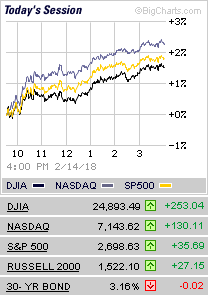The Federal Reserve voted last week to raise interest rates, and judging from the amount of hype around the move, you might think the sky is falling. But history suggests that investors have little to be concerned about.
Here’s a look at what’s happening: On Wednesday, December 16th, the Fed voted to raise key short-term interest rates by a quarter of a percentage point. This marked the bank’s first rate increase in more than nine years, and the start of a cycle of interest-rate increases.
Given current economic conditions, the Fed says, it will likely continue to increase rates in a “gradual” manner. The expectation is that a series of small increases will bring rates to around 1.375% by the end of 2016. The Fed’s long-range target for short-term rates is 3.5%—which still leaves rates lower than in 2006.
The Fed has held rates near zero since the financial crisis to help spur economic recovery. But now, a number of factors—including employment, gross domestic product, and inflation—look healthy enough to warrant increasing rates.
Effectively, the Federal Reserve is taking its foot off the gas and tapping the brakes. There are two important reasons for doing so. Low interest rates equate to cheap money, and the longer money stays cheap, the more likely it is that bubbles—like the real estate bubble a few years ago—inflate.
Raising rates now also gives the Fed ammunition to fight any future recession. When it needs to down the road, the Fed will be able to step on the gas once again.
For investors, a strong short-term market reaction, whether positive or negative, seems unlikely. The Fed’s rate increase surprised absolutely no one; the bond and stock markets factored it into prices long ago. On the day of the Fed’s announcement, the S&P 500 index closed up a healthy 1.45%. The next day, markets were flat.
Looking over the longer term, markets have historically performed well in situations like the current one. Since 1946, stocks have risen about 3%, on average, in the year following the first rate increase of a rate-increase cycle. There’s no guarantee future results will be the same, of course. But the history certainly doesn’t give any reason for alarm.
It’s also important to note that the Fed plans to move gradually. When rate increases have followed a slow upward trajectory, markets have returned about 11% on average in the year after the first increase, according to Ned Davis research. When the Fed has moved quickly, on the other hand, stocks have been down an average of 3% a year after the initial increase.
The Fed has not guaranteed that it will raise rates slowly, of course. An unanticipated development like soaring inflation could cause it to quicken its pace. But most observers see that as unlikely.
The bottom line: If you have a solid investment strategy in place, there’s no need to make a course correction. If, on the other hand, your goals, risk tolerance, or time horizon have changed, you’ll want to speak with your financial advisor about adjusting your portfolio accordingly. In our next blog, we’ll look at what rising rates are likely to mean in other areas of your financial life.

